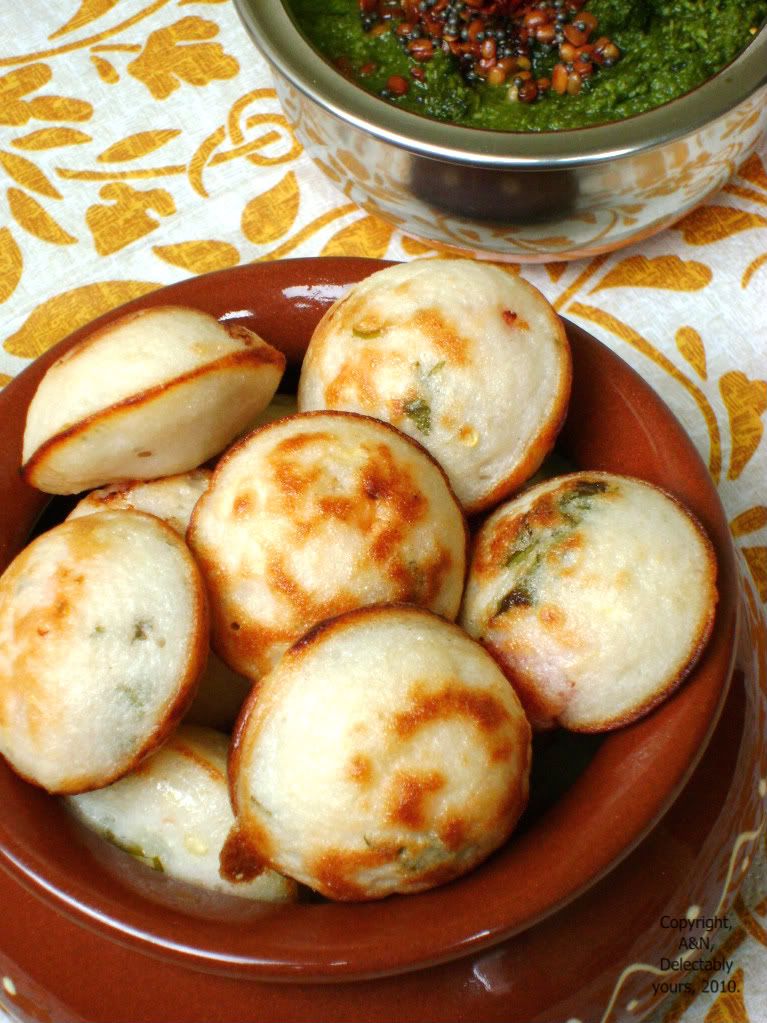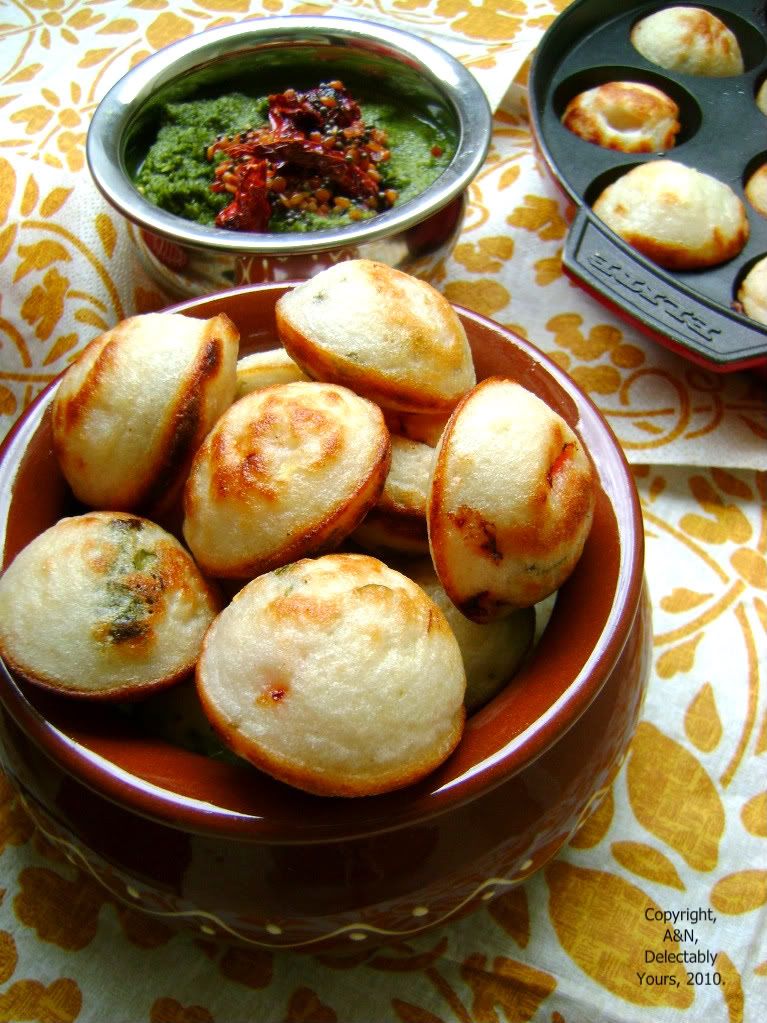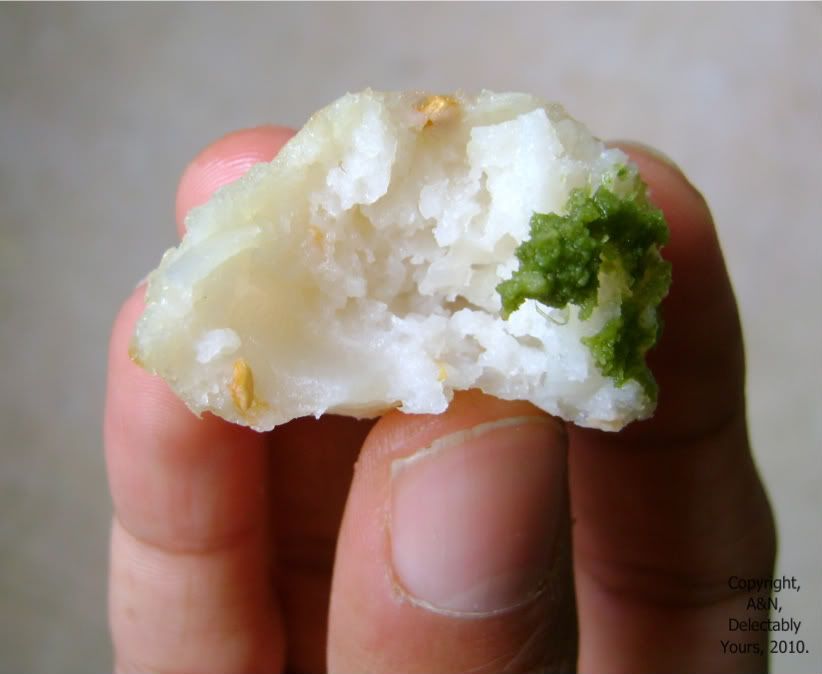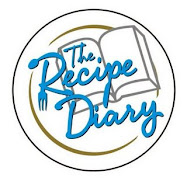*scene change - time moves - a year later*
Wednesday, June 16, 2010
Kuzhi Paniyaram
*scene change - time moves - a year later*
Wednesday, March 11, 2009
Lemon Rasam

Rasam was a staple in my house. Like, am sure, many other South Indian households. However, my grandmother was a Tamilian settled in Karnataka for ages and had adapted the Kannada style of cooking very well. She always made what is popularly known as the Mysore Rasam. It wasn't a delicacy or a specialty in my house. It was regular. So, I initially hated Rasam. Its only lately that I've fallen in love with Rasam and acknowledge its therapeutic properties. When my granny took a break, and my mom cooked, the Rasams she made were Milagu Rasam, Jeera Rasam and Lemon Rasam. Never Mysore Rasam. So, these Rasams were special meals for us :) Now, for A and me, Lemon Rasam is a staple if we cook South Indian food. I love citrusy flavours and A loves traditional South Indian food. So there, this clicked! Every single time that we've entertained with South Indian food, I've made this Rasam and have received only compliments! Frankly, I'm not a great cook. Actually, I never cooked thanks to my grandmother's rules. But with this Rasam, I'm a natural! I called my mom once for the recipe, and since then, this recipe rules, and works out fantastically well every time I make it. Now, enough has been said! Here is the recipe.
Ingredients
1 cup Toor Dal or Pigeon Peas - cooked to a pulp in the pressure cooker or microwave
1 large Lemon
1 Tomato, chopped into chunks
2-3 tbsp ginger chopped, finely. I add more than this, usually ;) (If you don't like ginger, you can remove them later, but DON'T skip the ginger!)
1tbsp Jeera or Cumin
2 tsp turmeric powder
3-5 green chillies, finely chopped
1 tsp ghee
1-2 cups water
A handful of coriander, finely chopped
Salt to taste
1. Cook the Dal or the pigeon peas until mushy.
2. Fry the Jeera/cumin seeds in the ghee. Add the chillies, ginger and the cooked Dal and let it bubble away.
3. Add water to thin the Dal out. You can add as much water as you want to make the Rasam as watery as you want. I like it watery!
4. Add the tomatoes, turmeric and salt, and let the mixture simmer until it comes to a boil. Add more turmeric if this doesn't give you a nice bright yellow colour.
5. Turn off the gas, let it rest for a minute or so, squeeze the juice of one full large lemon into the Rasam. Adjust the lemon juice per your desire for tanginess. I like it tangy :)
6. Add the chopped coriander and serve hot with some rice!

My mom was super smart about leftover Lemon Rasam too. She added onions and thickened the leftovers (they hardly need any thickening coz the liquid part is usually the first to be consumed!) to make Dal for Roti the next day. Since Roti-Dal was quite North Indian for us, that was a treat too!
This recipe goes out to MLLA, hosted by Laurie of Mediterranean Cooking in Alaska and conceptualized by Susan of The Well-Seasoned Cook. and to the Lentil Mela hosted by Ashwini.
Back in India, we drink/eat soup only when we dine out. I don't want to generalize this, but even the concept of a 'three course meal' is quite different than what is perceived here in the U.S. For a lot of Indians, a three course meal consists of three entrees and eating one entree with rice or roti comprises one 'course' ;) Of course, yoghurt or curd (that is the more common term used in India again :) could also be considered as an entree. Rasam in many ways is our soup. So, this one goes out to Lisa of Lisa's Kitchen, the brain and host of No Croutons Required. Literally, in this case ;) Or, or, or, you can dunk some papad in the Rasam like A does, always and slurp them up. There you go, you can have the croutons and eat it too!

But then, this post really goes out to Amma. My Amma. Like I said, I've always neglected to acknowledge my mom. I've fought with her, still fight like crazy with her and disappoint her all the time. However, there have been very few instances that she's disappointed me, and its hardly been a disappointment as I learn now, years later, sitting away from her. She's changed too. She understands me, my feminism, my activism better now, and I appreciate her for that. It takes courage and a lot of love to do this and Amma, thank you for that.
Now Amma, I wish you'd stop asking me to eat well and exercise well. Just eat well will do ;)
P.S. - We are seriously working on our pictures. With lights, angles, background etc etc! Unfortunately, we chose to showcase Rasam in a steel utensil this time. LOL! So, we'd LOVE direct and honest feedback on our pictures going forward. Hey, suggestions and tips will do too! For some entertainment, see how nimble the man is, standing on a chair taking a pic of the Rasam on top of a chair on top of the table :D

Sunday, August 3, 2008
Pitlai, Pawakkai Pitlai ;)
This vegetable surely deserves to be introduced like James Bond :) I've always loved karela/bitter-melon/pawakkai thanks to my grand-mom. One of my favourite preparations of bitter melon is curry made with tamarind. The bitterness remains but is so less compared to other pawakkai preparations. This preparation is one of my all-time faves. I'd come back from half-day school on Saturday to be greeted by Pati with steaming rice, ghee and this curry. I'd just lap it up and eat more and more :) However, my granny - my dad's mom is from Karnataka, a Tamilian from the Karnataka side. So, we never, never made stuff like vethal kuzhambu, parippu usli, pitlai, and many such very Tam preparations. If made at all, it was for a special occasion! So much so that when I learned to make vethal kuzhambu before my marriage (its one of my faves!) and I told A ( an accomplished cook!) proudly that I'd made 'Puli Kuzhambu' ( that is what we call it at home) he went on to tell me that he makes it every now and then and that it is actually Vethal Kuzhambu. He even gave me suggestions to make it better! And here I was, always thinking that Vethal Kuzhambu was some exotic, tough dish to prepare :)
When I got married to A, though they've been all over the country, the South Indian food that my mother-in-law comes up with is very Tamil and super-tasty. I rediscovered my Tamil genes with A ;) Started speaking better Tamil, cooking more South Indian food, learning more about the Tamil cuisine. This is one such preparation: Pawakkai Pitlai. A loves this, and bought this vegetable from the Farmer's Market and asked his mom for the recipe. The wonderful cook that he is, he cooked this for us one night for dinner. Along with this, he made another Tamil classic - Uruzhakizhangu Masaal (another post, another time!) because I cannot eat rice with a curry! And this is how our dinner looked. Absolutely decadent, and high up there in terms of taste and memories :)

4. Roast the coriander seeds, red chillies, urad dal and the pepper. Add coconut and grind it into a smooth paste. Do not add too much water. Just a little to allow it to grind.
5. Now add the tamarind extract in a large bottomed kadai/pan, throw in the salt and the turmeric and the Sambar powder and bring it to a boil. Note that this thickens the mixture, so keep adding water to keep the consistency gravy-like.
7. Add the dal mixture now, and mix well and let it cook for another 5 mins
9. In another pan, prepare for the tadka. Fry the mustard seeds, asafoetida and curry leaves in hot ghee/oil and add to the Pitlai. And your Pitlai is ready to be served with steamed rice.
I know this seems like a long list of ingredients and the cooking steps are long too! However, this is one of the simplest traditional recipes I've tried and its a favourite now :)









.jpg)
